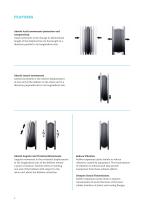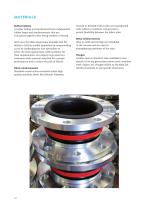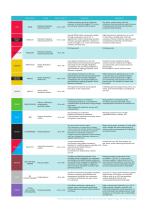
Catalog excerpts

RUBBER EXPANSION JOINTS ENGINEERED EXPANSION JOINTS
Open the catalog to page 1
MACOGA Rubber Expansion Joints INTRODUCTION FEATURES CONSTRUCTION DETAILS ANALYSIS AND DESIGN PRACTICES TYPES OF RUBBER EXPANSION JOINTS OPTIONAL DEVICES / ACCESSORIES DOG-BONE TYPE EXPANSION JOINTS ASSEMBLY INSTRUCTIONS ON-SITE SERVICE
Open the catalog to page 3
MACOGA HAS MORE THAN 40 YEARS OF EXPERIENCE IN EXPANSION JOINTS AND OFFERS THE MOST COMPLETE RANGE EVER CONCERNING SIZES, MATERIAL AND SHAPES TO MEET ALL APPLICATIONS. Thermal growth, equipment movement, vibration or pressure pulsation may generate movement in a piping system. When this movement is not absorbed by the piping system itself, an expansion joint is the perfect solution. A Rubber Expansion Joint is flexible connector fabricated of natural or synthetic elastomers, fluoroplastics and fabrics and, if necessary, metallic reinforcements used to absorb movements in a piping system...
Open the catalog to page 5
Absorb Axial movements (extension and compression). Axial movement is the change in dimensional length of the bellows from its free length in a direction parallel to its longitudinal axis. Absorb Lateral movements. Lateral movement is the relative displacement of one end of the bellows to the other end in a direction perpendicular to its longitudinal axis. Absorb Angular and Torsional Movements. Angular movement is the rotational displacement of the longitudinal axis of the bellows toward a point of rotation. Torsion refers to twisting one end of the bellows with respect to the other end,...
Open the catalog to page 6
ADVANTAGES Reduced fatigue factor Given the inherent characteristics of natural and synthetic elastomers, they are not subject to fatigue breakdown or embrittlement and prevent any electrolytic action because of the steel-rubber interface of joints and mating flanges. Extraordinary resistance to abrasion and corrosion A wide variety of natural, synthetic and special purpose elastomers and fabrics are available to the industry. Materials are treated and combined to meet a wide range of practical pressure/temperature operating conditions, corrosive attack, abrasion and erosion. See table of...
Open the catalog to page 7
Power generating stations Oil & gas Desalination Cooling systems Pumps Chemical plants Heating, ventilating and air conditioning Shipbuilding Off-shore applications Water treatment plants Sewage Sanitary piping systems Pulp and paper plants Piping systems for chilled or hot water Cooling
Open the catalog to page 8
CONSTRUCTION DETAILS MACOGA rubber expansion joints are designed following the guidelines of the FSA (Fluid Sealing Association) Non-Metallic Expansion Joints Technical Handbook, ASTM F1123 - 87 Standard Specification for Non-Metallic Expansion Joints and always complying with the European Pressure Equipment Directive 2014/68/UE for the specified operating conditions. Rubber Expansion joints are fabricated with an elastomeric tube reinforced with multiple plies of fabrics covered with synthetic rubber. The inner tube is made of natural rubber, synthetic rubber or blend of synthetic rubber....
Open the catalog to page 9
MATERIALS Rubber bellows A rubber bellow is manufactured from independent rubber layers and reinforcements that are vulcanized together after being molded or formed. With over 35 rubber elastomers available and the ability to further modify properties by compounding it can be challenging for non-specialists to select the most appropriate rubber polymer for their requirements. Our experts may assist our customers with material selection for a proper performance and to reduce the risk of failure. Fabric reinforcements Standard constructions normally utilize high quality synthetic fabric like...
Open the catalog to page 10
DOUBLE DOUBLE YELLOW YELLOW Ethylene Propylene Diene Monomer Ethylene Propylene Diene Monomer HT Ethylene Propylene Diene Monomer DW Nitrile Butadiene Rubber Nitrile Butadiene Rubber HP White Nitrile Butadiene Rubber Chloro- sulfonated polyethylene synthetic rubber Styrene-butadiene rubber Isobutylene isoprene rubber Natural rubber VITON FKM (ASTM) FPM (DIN/ISO) Hot water, cooling water with salt solutions, chlorine solutions, ester, ketones, compressed air (oil free) and chemicals except for hydrocarbons. Special EPDM rubber compound suitable for high temperature up to 140 °C applications...
Open the catalog to page 11
ANALYSIS AND DESIGN PRACTICES Our analysis and design practices include: —— Finite Element Analysis (FEA) —— Pipe Stress Analysis —— CAD —— 3D Modelling We use the most sophisticated analysis and calculation software to design pipe systems and select the most appropriate Expansion Joints providing a complete pipe stress analysis when required. With our 3D mechanical CAD software our engineers design Expansion Joints to the same conditions that they’ll experience in the real world before they have been built. This is a design validation tool that helps our engineers to test the designs...
Open the catalog to page 12
TYPES OF RUBBER EXPANSION JOINTS This model absorbs all the movements in any one length of piping. MOULDED OR CUSTOM MADE EXPANSION JOINTS WITH FLOATING FLANGES MAC-W AND MAC-WT SERIES These are the standard moulded or custom made Expansion Joints consisting of high quality rubber body incorporating floating flanges. Unrestrained expansion joints under pressure will exert a considerable axial force on the pipeline, i.e. anchors. It is essential that checks are carried out when the expansion joint is first pressurized to ensure that there is no unforeseen stretching of the bellows. If...
Open the catalog to page 14
MAC-WT Series MAC-WT / Restrained As MAC-W but incorporating control units/tie rod system. A control unit assembly is a system of 2 or more control rods placed across the expansion joint from flange to flange to set the maximum allowable expansion/contraction of the expansion joint and that will contain the pressure thrust. Recommended on most applications to prevent damage due to excessive pipe movements, each rod incorporates double nuts on each end to keep the expansion joint from over- elongating and spherical washers to allow Lateral, Angular and some Torsional movements as well as to...
Open the catalog to page 15All Macoga catalogs and technical brochures
-
METALEXPANSIONJOINTS
32 Pages



